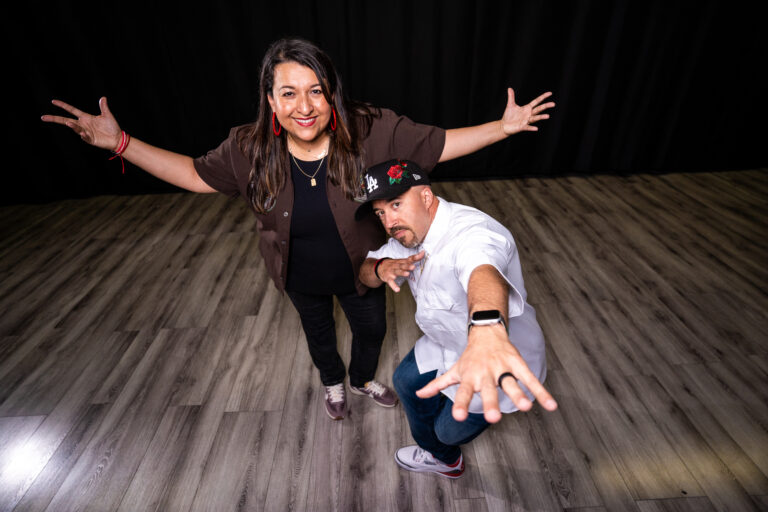OSU professor emeritus Vicki Blaine works with dance students (L to R) Sarah Gibbons, Katie Stehura, Vicki DeRenzo and Katy Gilmore
Last spring, dance major Annie Flaherty auditioned a piece for the Studio Dance II concert at the University of Illinois at Urbana-Champaign (UIUC). Flaherty, then a sophomore, was one of 22 student-choreographers vying for a spot on the program—and her piece wasn’t selected. But that didn’t keep her from presenting her work. “I thought about how other artists weren’t stopped by less-than-positive feedback,” Flaherty says. With help from other students and encouragement from Jan Erkert, the dance department head, Flaherty produced her own, informal showcase.
It’s no surprise Flaherty felt compelled to take charge. UIUC’s dance department encourages “student agency,” a concept that allows students to play a more active role in shaping their educational experiences. At Ohio State University, the dance department employs a “contract curriculum,” which fosters a similar environment. No matter the name, these programs help students develop the inquisitive mindset, decision-making skills and maturity they need to succeed as dance professionals.
At UIUC, student agency is part of broad curriculum goals called the Five Domains of Knowing, which Dance at Illinois (the UIUC dance department) began implementing in the fall of 2009. These domains—context, reflection, inquiry, synthesis and agency—increase the academic and professional expectations placed on students.
During their first two years at UIUC, students follow a structured curriculum; they are given more freedom as they progress in the program. This increased independence enhances a student’s ability to make choices about the direction of her own research and career. The department’s curriculum petition system, for example, lets more advanced students tailor their courses to fit their interests. Students must write a detailed explanation justifying proposed curricular changes. A student interested in lighting design might petition to take a lighting course in the theater department. Had the student taken a production course in the dance department, she would have received an overview of many topics, only grazing the surface of lighting design.
Dance at Illinois juniors and seniors can also select their technique class levels. “We wanted to get rid of the ‘I’m a good dancer/I’m a bad dancer’ mindset that surrounded level placement,” Erkert says, “and focus instead on helping students assess where they would work and learn best.”
In the dance department at Ohio State University, the contract curriculum plan offers similar freedoms. During their first two years, OSU dance students take a foundation curriculum, which emphasizes breadth and encourages exploration. Beginning the spring semester of their sophomore year and continuing throughout the rest of their collegiate careers, students participate in advising colloquiums with a group of peers and faculty. The colloquiums, which meet three or four times each semester, act as a sounding board for students to develop plans for future coursework. “There is some framework,” says Susan Van Pelt Petry, the dance department chair at OSU. “But it is pretty wide open overall.”
OSU’s undergraduates can take two courses outside of the dance department that count toward their dance major. Students choose these courses in their colloquiums and create written proposals explaining why the courses are relevant to their specific interests. In the fall of their junior year, the students’ plans are written as contracts and signed by both the students and their advisors.
The contract curriculum was introduced in 2006 after a faculty retreat sparked a conversation about flexibility in OSU’s BFA program. “Someone can be a choreographer, performer and a dance writer all at once,” Van Pelt Petry says, “and we as a collegiate dance program should allow space for all of those things to develop.”
While it might seem like giving students more control would lighten the load for faculty, OSU faculty have found it’s actually more demanding. “We have students being entrepreneurial, but independent research projects take more faculty time and production support,” Van Pelt Petry says. “But the faculty who get involved say it is very rewarding.”
At UIUC, too, the dance community is reaping the rewards of increased student involvement. Having proven a high level of maturity in their level placement choices, the student body was deemed ready to take on additional responsibilities.
Starting in 2010, students seeking departmental funds for independent projects must prepare grant proposals. (In prior years, there was no application process for departmental awards; support was based solely on merit and scholarship.) The 2010 redesign was an effort to level the playing field, but it hasn’t quite hit the mark. “Though we had a high number of proposals in 2010, many students were denied funding due to poor writing skills,” Erkert says. “Now we know that we need to do more work during the year to help students learn to write grants.”
It’s an ongoing process of refinement and readjustment, which helps faculty provide the skills that will allow each student to flourish. “It offers so many more options for students to create their own futures,” Flaherty says. “No one is doing the exact same thing professionally, but they are all successful.” DT
Alyssa Schoeneman earned a BFA in dance from the University of Illinois at Urbana-Champaign, where she is currently pursuing an MS in news-editorial journalism.
Photo: OSU professor emeritus Vicki Blaine works with dance students (L to R) Sarah Gibbons, Katie Stehura, Vicki DeRenzo and Katy Gilmore. (by Melissa Bontempo, courtesy of OSU)



